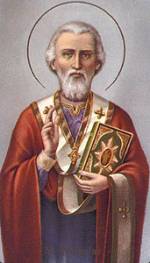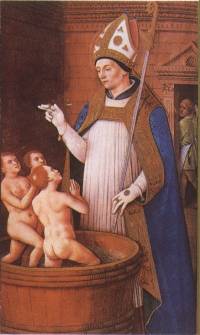
St. Nicholas of Myra
Born: unknown
Died: December 6, 342 or 345
Canonized:
Feast Day: December 6
Patron Saint of: bakers, brewers, brides, children, merchants, pawnbrokers, travelers
Also known as Nicholas of Bari.
Though he is one of the most popular saints in the Greek as well as the Latin Church, there is scarcely anything historically certain about him except that he was Bishop of Myra in the fourth century.
Some of the main points in his legend are as follows: He was born at Parara, a city of Lycia in Asia Minor; in his youth he made a pilgrimage to Egypt and Palestine; shortly after his return he became Bishop of Myra; cast into prison during the persecution of Diocletian, he was released after the accession of Constantine, and was present at the Council of Nicaea. In 1087 Italian merchants stole his body at Myra, bringing it to Bari in Italy.
The numerous miracles St. Nicholas is said to have wrought, both before and after his death, are outgrowths of a long tradition. There is reason to doubt his presence at Nicaea, since his name is not mentioned in any of the old lists of bishops that attended this council. His cult in the Greek Church is old and especially popular in Russia. As early as the sixth century Emperor Justinian I built a church in his honour at Constantinople, and his name occurs in the liturgy ascribed to St. Chrysostom. In Italy his cult seems to have begun with the translation of his relics to Bari, but in Germany it began already under Otto II, probably because his wife Theophano was a Grecian. Bishop Reginald of Eichstaedt (d. 991) is known to have written a metric, "Vita S. Nicholai." The course of centuries has not lessened his popularity.
His representations in art are as various as his alleged miracles. In Germany, Switzerland, and the Netherlands, they have the custom of making him the secret purveyor of gifts to children on 6 December, the day on which the Church celebrates his feast; in the United States and some other countries St. Nicholas has become identified with Santa Claus who distributes gifts to children on Christmas eve. His relics are still preserved in the church of San Nicola in Bari; up to the present day an oily substance, known as Manna di S. Nicola, which is highly valued for its medicinal powers, is said to flow from them.
[ Source: The Catholic Encyclopedia ]







